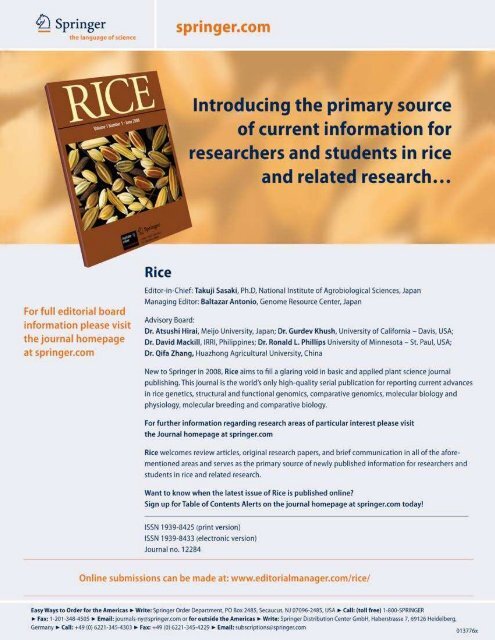"Scuba rice" - adron.sr
"Scuba rice" - adron.sr
"Scuba rice" - adron.sr
You also want an ePaper? Increase the reach of your titles
YUMPU automatically turns print PDFs into web optimized ePapers that Google loves.
Asian consumption to drivemarkets in 2009 by V. SubramanianWorld Grains Trade Summit sees Asian consumptiondriving the world grains market in 2009The global financial crisismay have slowed theconsumption of variouscommodities, but Asiandemand for grains (as food and feed)remains strong. The first WorldGrains Trade Summit held on 17 to18 February 2009, organized by theCentre for Management Technologyin Singapore, reported that demandfor 2009 will largely come from Asia.As the world continues to recoverfrom the effects of the 2008 crisis,the Summit expressed concerns aboutthe current grain market riddledwith risks and slowed by the worldeconomic downturn. The participantshoped for the market to be lessvolatile, but the Summit reportsindicated that this year’s marketwill be affected by policies, climatechanges, and other factors that maydi<strong>sr</strong>upt supply such as pests andnatural calamities.The growing Asian populationAccording to Diego Barber, globalhead of grains at Noble Group,Asia is home to 60% of the world’spopulation, which continues to growat 1–1.4% per year. He stressed thatthe region will play an importantif not critical role in bringing moredemand to trade in grains. In thesevolatile times, Asian grain demandhas been upheld by populationgrowth, rising per capita incomes,strong food policies, as well asdecreasing energy and food prices,which helped reduce the risk ofinflation.“Global inflation reversed itssharp upward trend after 2008as energy and food prices fell as aresult of the economic slowdown,”Barber said. “Lower inflation ratesand declining food prices gave Asianconsumers some relief, which helpedmaintain consumption patterns.”Challenges emerged, however,from the global credit crunch, thedeclines in economic growth rates inkey emerging markets (the economiesof China and India were expectedto drop by 3–5%), and increasedawareness and policy initiatives toensure food security.Nevertheless, the changingnutritional trends in the emergingAsian markets and the regionalgovernments’ efforts to maintainand protect strategic reserves havecreated a positive demand for grains,which would help drive consumptiontrend.False sense of comfortRajeev Raina, head of OlamInternational’s Rice Division,said that, following the marketdevelopments of 2008 and theirimpact on trade this year, ricemarkets may offer the world a falsesense of comfort.Not known to many, the worldsaw high production from 2003 to2008. This increase in productionis misleading because, for 4 years(2003-06) within that period,consumption exceeded production.Stock amounts also rose since late2008 on the back of food securitymeasures. Since 1991, yields havebeen falling behind populationgrowth, which suggests that theproduction comfort zone has, for 18years now, been eroded by the risingtide of consumption. Raina said thatthe world needed a 1.5% yield increaseevery year for the next 12 years just toretain the current balance.Production increased last year inThailand, India, Pakistan, and evenVietnam because of the rice pricehike. Prices subsequently went down,which gave consumers a relative senseof security. This false sense of reliefmay be further exacerbated by India’sJean Craven, Export Trading Corporation, detailingthe finer points of trading with Africa.possible return to the market. Indiabanned exports of nonbasmati ricelast year following the food crisis. If itlifts the ban soon and releases its ricestocks, chances are prices will comefurther down. Many fail to realize,however, that the fundamentals havenot changed. The world continuesto consume at a rate faster thanproduction growth. The marketneeds efforts to overcome this gap.But, results do not happen overnight.It may take more than 10 years tosee the results from any researchinitiative; hence, we can expect riceavailability to be tight over the nextdecade.In addition, although bufferstocks are rising, amounts remainrelatively low. Hence, potentialshort-term imbalances in supplyand demand are becoming morepronounced. Government exportrestrictions as well as climate changescan easily tip this finely balancedsituation over to the critical side.The Summit cautioned theparticipants against the possiblerisks of today’s market. Among themany key features that would affecttrends were the financial crisis,how investment funds will react orwhen they will return, the long-termpromise of research, and the potentialbenefits offered by geneticallymodified crops. The event’s presenterspinned much hope on Asia’s strongconsumption trend, which wouldhelp keep demand firm. Prices andpolicies, however, will still greatlydetermine the market’s capacity tomeet these future needs.v. subramanian36 Rice Today April-June 2009 Rice Today April-June 2009 37
















